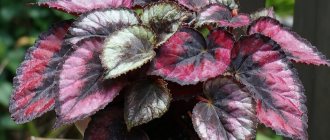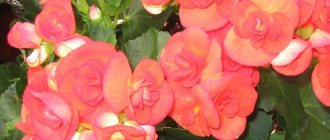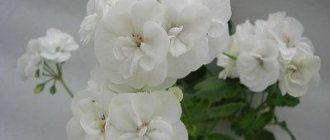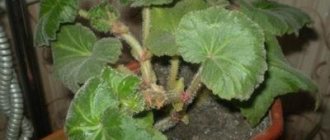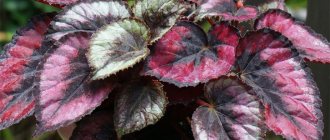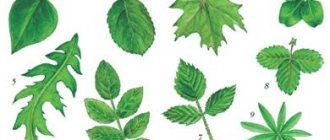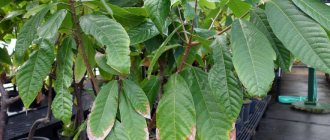The diversity of begonias is amazing: botanists count about 1,600 species, and the number of currently existing cultivated varieties and hybrids is beyond counting (1). The main habitat of begonias in the wild is the tropical rainforests of South America and Africa, as well as the mountainous regions of Asia.
The first representatives of the species were described by the French monk-researcher Charles Plumier during an expedition to the islands of the Antilles archipelago. The organizer of the expedition was the quartermaster of the French fleet in Marseille, Michel Begon, in whose honor Plumier named the new genus of plants he discovered.
Begonia has been cultivated since the 19th century, and the appearance of the first hybrid varieties dates back to the same time. There are not only indoor, but also garden varieties of begonias that are grown in open ground (2).
Origin of begonia and distinctive features
There are more than 1 thousand species of begonias in nature. The largest number of varieties is found in South America, followed by Asia (India, the Himalayas, Sri Lanka), and western Africa in third place. There is an assumption that Africa is the birthplace of begonias, from here they spread to Asia and America. In the wild, plants are found in humid subtropics and mountains.
Begonia in the wild
The family was first described by the French botanist Charles Plumier. In 1683, under the leadership of the intendant of the French colonies, Michel Begon, he visited the islands of the Caribbean with an expedition. There the scientist discovered plants that were unknown at that time, gave them a description and named them after the organizer of the trip.
The begonias known today differ greatly from each other in size, shape, coloring of leaves and flowers. Some are perennial, others are annual. There are herbaceous and shrubby begonias, with creeping or thickened rhizomes. But there is also something in common that unites these plants into one family.
Characteristics of begonias:
- All types of begonias have an asymmetrical, oblique leaf;
- flowers are monoecious;
- perianths - brightly colored, unequal;
- the fruit with seeds looks like a capsule;
- all begonias grow in approximately the same natural conditions: diffused sunlight, high humidity, temperature +13... +22 ⁰C.
Video: the wealth of types and colors of a flower
general characteristics
Begonia received its name in honor of Michel Begon, a famous botanist and quartermaster of the French fleet. This is a large and diverse family, so the varieties differ significantly from each other: herbaceous and bushy, semi-bushy, creeping, tuberous, annual and perennial.
Separately, there are decorative species, notable for their large bright flowers. And separately - deciduous, with rich bright foliage in rich colors. The stems of bushy varieties resemble bamboo. They are resilient and erect. In creeping begonias they are thin and flexible. Rhizomatous ones are thick and mundane. Beautifully flowering begonias are mainly grown in gardens.
Photo: zulminakr.ru
Begonias - flowers for apartments, gardens and offices
As an ornamental crop, begonia has been developing since 1856, when breeders began to create its hybrids. Tuberous, large-flowering varieties appeared, the most famous ones being bred in Belgium. Keeping these plants at home is not too difficult, otherwise they would not be so popular. Begonias are grown in open ground and on window sills; they are used for landscaping residential premises and offices, in compositions and separately. Flowers are planted in baskets and pots to decorate walls, furniture, and are also used as ground cover plants. Ever-flowering varieties are suitable for any flower beds, even carpet ones. Tuberous varieties are grown on balconies, verandas, and enclosed courtyards.
Begonia as a decoration for buildings
Care at home has its own nuances, for example, tuberous plants require a period of rest. All begonias love moist air, but do not tolerate damp soil. However, any novice gardener can grow this plant. After all, if something went wrong and the begonia began to dry out, you can take a cutting or a leaf and start growing the begonia again, taking into account past mistakes. The culture is able to reproduce even with a piece of leaf, which very quickly turns back into a lush and beautiful indoor plant.
Watering
Begonia is a plant with increased air humidity requirements. Information on how to water a flower will not be superfluous for plant connoisseurs.
To water the flower, use settled water at room temperature. Make sure that the water does not stagnate in the pot, otherwise the roots may rot.
Decorative deciduous varieties with fibrous roots should be watered abundantly during the period of active growth.
Tuberous varieties require moderate watering. It is necessary to re-moisten the soil only after the soil in the pot is half dry.
If begonia grows in a room with dry air, then its tips will begin to dry out over time, and the beautiful flowers will dry out. Correct the situation immediately. Install an air humidifier next to the flowers or purchase a tray with a grate under which wet expanded clay will be placed.
Place the pots with begonias on the grid, and the moisture evaporated from the expanded clay will allow the begonias to grow in comfortable conditions.
Varieties of root begonias
Everblooming
The main difference between the species is its constant flowering. You can plant such a plant in the garden in the summer, take it indoors for the winter, and it will bloom everywhere all year round. These are perennial herbaceous begonias. External signs, in addition to constant flowering, are rounded leaves and small height: tall - up to 36 cm, short - from 8 cm. Many varieties have been bred with green or burgundy leaves, white, yellow, pink or coral flowers, which, in turn, They can be terry (in the form of roses) or simple.
Examples of plants in the photo
Bada Bing WHITE Bada Bing Rose Bada Bing Scarlet
Accord Purple Terry Storyteller
Lucenec
Coral
Indoor herbaceous begonias bloom in early spring and fully justify their name. The flowers are painted in different shades of red, and the branched flower stalks hanging down under the weight of the buds are very similar to corals. The leaves also look romantic: elongated, matte, speckled, with jagged edges reminiscent of angel wings. Begonias look most impressive in pots on stands. They are very unpretentious in care. Bush height - up to 90 cm.
Peduncles resemble corals in both shape and color
Deciduous begonias
The species is famous for the decorativeness of its leaves, and the flowers of deciduous begonias are small and inconspicuous. These are often non-flowering perennial plants. They differ from other species in their capriciousness. So, leaf begonias cannot be kept in the open air, that is, these begonias love greenhouse conditions, high humidity, and diffused light. In the country house or on an open balcony they will die. The main feature of the species is large (15–20 cm) and beautiful leaves. They can be decorated with colored pearl spots, exquisite patterns, contrasting colors, silver glitter or mother-of-pearl shimmer. The stems are pubescent, the reverse side of the leaves usually has a red tint.
Photo gallery: Deciduous begonias
Begonia Royal Begonia Rex
Masoniana
Manikata Begonia Metallica Begonia Crednery
Corallina Alba Pict
Decorative deciduous begonia: spotted or speckled variety (Maculata Raddi)
This is a bush type of begonia, a herbaceous subshrub with an erect stem, which under favorable conditions reaches about a meter in length and width. Therefore, it is grown most often in greenhouses and winter gardens. It has elongated, asymmetrical leaves in the shape of a heart with an oblique center. Their length is 10-15 cm, width - about 5 cm. The tip is pointed. Visually, the leaves resemble angel wings in their shape. (For this similarity, our grandmothers called this begonia that way). The leaf plates are very dense and glossy. Their rich green background is literally dotted with silvery-white spots. The back side of the leaves has reddish-brown-red shades. The petioles are short, about 2 cm. The flowers are of unusual shape, white or light pink. They are formed on a drooping peduncle hanging down in small inflorescences from April to July.
Varieties of tuberous begonias
These begonias are grown in shady corners of the garden or on balconies. Their flowers are very beautiful, depending on the variety they look like roses, carnations, daffodils, peonies, and camellias. Stems are fleshy, translucent; leaves are asymmetrical, heart-shaped. Hidden underground is a rhizome that has grown into a tuber. In open ground, begonias bloom from June to September, and indoors from spring to December, then a dormant period begins. The above-ground part dries out, and the tuber is stored until the next season.
Photo gallery: Tuberous begonias
Begonia Summer in Peterhof
Non-Stop Go-Go pink Tigantea Flora Plena
Diantiflora Plena Crispus Marginata
Types and varieties of decorative deciduous begonias for growing at home
Begonia Curly Fireflush. Begonia Dollar Down. Begonia Escargot.
Begonia Garden Angel Silver. Begonia Green Silver.
Begonia Harmony's Red Robin. Begonia Jolly Holly. Begonia Jurassic Rex. Begonia Montgomery.
Begonia Looking Glass. Begonia Midnight Sun.
Begonia Raspberry Swirl. Begonia Silver Bells.
Begonia Silver Dollar. Begonia Silver Jewel.
Begonia Silver Leaves.
Begonia Silver Spirit. Begonia Silver Spirit.
Begonia Specter Silver.
Begonia diadema. The variety of species and varieties of begonia can amaze any gardener - both beginners and quite experienced ones. We introduced you to only one group of these amazing flowers - the decorative deciduous species of begonia. All of them are easy to care for, stunningly beautiful all year round, easy to reproduce and have a lot of useful properties. For now, choose and purchase the varieties you like, and we will write in the next article how to care for them indoors.
Elatior or hybrid begonias
Hybrid begonias were bred in England by crossing two species: root Socotrans (from the island of Socotra in the Indian Ocean) and tuberous. The result was a very beautiful plant, similar to a tuberous one, but with a regular root. Blooms in winter. Due to the compactness of the bush and the abundance of flowers, closely arranged in several tiers, this begonia is called a “bouquet in a pot.” With good care, Elatior blooms not only in winter, but almost continuously, for several months in a row. The most famous varieties: Elatior Borias, pleasing with pink double flowers with a white edge, and Elatior Baladin with flowers of different shades of pink: from white to red.
Photo gallery: Begonia Elatior
Elatior Borias
Elatior Baladin
Elatior mix
Decorative foliage begonia: variety credner or pig's ear (Credneri)
The variety was obtained by crossing Metallic begonia and Scarf begonia. The leaves are light green with a metallic sheen on top and bright pink underneath. In the light they shine through like the auricle. Bush type.
Royal Begonia or Rex.
Begonia "Crednera" or "Pig's ear".
Ampelous begonias
Another type of luxurious indoor plants, the popularity of which has been growing in recent years. This group includes root, tuberous, and hybrids. They are united by one feature - hanging shoots strewn with flowers of different shapes and colors: white, yellow, red, orange, pink. The bright asymmetrical foliage also looks impressive. Ampelous varieties are planted in balcony boxes, flowerpots, and tall flowerpots.
Photo gallery: Ampelous begonias
Fire Cascade Begonia Venus
Begonia Margarita
Begonia Aphrodite Begonia Bella
Useful qualities of a flower
The leaves of the plant contain a large amount of phytoncides. Phytoncides are biologically active substances that are effective against pathogenic bacteria and fungi, in particular staphylococci.
Begonias effectively clean the air of dust, toxic substances and electromagnetic radiation.
Many plant owners have noticed that indoor Begonia flowers help improve immunity and mental activity, reduce fatigue and increase performance. Scientists and writers welcome the presence of this flower in their homes.
The healing effect of the flower has long been proven by herbalists. The green parts of the flower are an excellent antiseptic and have an analgesic and antiallergic effect.
Conditions for keeping begonias depending on the season - table
| Season | Feeding | Lighting (always diffused, partial shade) | Watering | Temperature |
| Spring | 1 time every 2 weeks | keep on the north window | moderate, in a tray when the soil dries to a depth of 1–2 cm | +17… +25 ⁰C |
| Summer | 1 time per week | |||
| Autumn | 1 time every 2 weeks | move to west or east window | room, not lower than +13… +15 ⁰C | |
| Winter | 1 time per month |
Rooted begonias in such conditions will bloom all year round or for many months (depending on the variety). For tuberous begonias, this table is only partially suitable. In autumn they are cut and stored for the winter in a dark and cool place (+12 ⁰C). Water once a month, only slightly moistening a strip of soil along the edge of the pot. At the end of February they put it out in the window, begin to water and feed it, like all other flowering varieties.
Video: Tuberous begonias: dormant period and cultivation
Let them get used to new conditions
Begonia lovers need to remember that when purchasing a plant, it needs to get used to new conditions. Before transplanting a flower from a portable container into a pot, you need to let it adapt to the new conditions.
You cannot replant the plant right away. You need to wait about 2 weeks after purchase, then carefully replant the flower.
Planting begonias
In Europe and the USA, it is customary to buy flowering begonia and throw it away after it has finished blooming. But this option is not suitable for Russians; we like to replant, feed, change pots. Begonias are replanted in the spring, and this is the season when you need to buy them. Without transplanting into nutrient soil, purchased begonia will soon die. Indeed, in the store-bought version, peat serves as the soil, and the plant lives off of nutrient solutions. Therefore, immediately after purchase, the begonia needs to be replanted.
Recent Entries
Lilac perennials that are beautiful, compact and do not crowd out other plants Why when buying seedlings you should not take the sellers’ word for it and how to determine the age of the plant using 3 signs Tomato seedlings have turned purple or whitish: why the color has changed and how to save the plants
In the same store, along with the flower, you need to purchase:
- drainage (expanded clay stones);
- soil (for begonias, violets or universal for flowering peat-based crops);
- perlite, or vermiculite, or sphagnum moss (for additional looseness of the soil, but not necessary);
- a pot 3–4 cm wider and deeper than the one in which the begonia is sold; Required: tray and drainage holes.
Excess water in the pot causes the roots of begonias to rot and the flower to die. Therefore, the soil needs to be loose, breathable, and water should not stagnate in it. In addition, begonias love acidic and fertile soil. It is not recommended to take soil from the house, country house or forest. Such soil is almost always infested with diseases and insects, and its acidity is unknown.
Photo gallery: What is needed to transplant begonias
Drainage is necessary for root respiration Perlite serves as an additional loosening agent Vermiculite is used instead of perlite or sphagnum to loosen the soil Sphagnum moss, along with perlite and vermiculite, additionally loosens the soil
Ready soil for begonias. If you don’t have it, a soil mixture for violets is suitable. Universal soil for flower crops
The new pot should be of such a size that the old one fits freely in it.
Stages of begonia transplantation:
- Take a new pot and pour a 2-3 cm layer of drainage into it.
- If there is additional leavening agent (sphagnum, perlite, vermiculite), then add a few spoons to the pot (depending on the size of the pot and begonia).
- Remove the begonia from the old pot and shake off some peat or soil from the roots.
- Place the flower so that it is at the same depth and fill it with fresh soil.
Video: How to transplant begonia
After replanting a homemade begonia, not a store-bought one, that has overwintered in an apartment, radical pruning of the bush is necessary. Remove all shoots, leaving three or four. In some varieties, only one stem grows, so you don’t have to remove the excess, you just need to shorten it. Strongly elongated bare stems with leaves at the top are cut by a third. After this, the lower sleeping buds will wake up, and young shoots will also begin to grow. As a result, a lush bush will grow again.
Transfer
The indoor plant grows quickly and needs periodic replanting. When the roots of the plant begin to peek out from the drainage holes, you need to think about transplanting it into a larger pot.
Water the plant generously to make it easier to free the begonia from the old soil. After freeing, carefully rinse the root part with warm water, remove rotten and damaged roots. To disinfect, leave the roots in a weak antiseptic solution for five minutes. Next, dry the roots and treat fresh cuts with charcoal powder.
Plant the treated plant in a prepared, larger pot, filling the plant up to the upper root collar and watering it generously.
Return the transplanted flower to its place and water it abundantly at first.
Young plants up to 3 years old tolerate transplantation well, but older plants are much worse and can be sick for a long time after transplantation. Experts recommend dividing an adult plant into several parts and planting it in different containers.
Caring for begonias
Watering
The top dried layer is loosened. And only when the soil dries to a depth of 1–2 cm can it be poured into the pan. The ideal way is to place the pot in a container of water until the soil is completely saturated. Then the pot is returned to the tray, and the excess water that has leaked into it is drained. The frequency of watering depends on the conditions in which the begonia is kept: on a sunny window, an open balcony, in the garden. In the open air they water every day, in an apartment, on a shady closed balcony - once every 2-3 days. The condition of the soil should serve as a guide. The water must be softened. To do this, it is filtered and settled.
Water for watering begonias can be softened and made acidic using peat: 1 kg of peat in a fabric or gauze bag is infused for 24 hours in 10 liters of water.
In addition, begonia is demanding on air humidity, but its leaves cannot be sprayed. There are several ways to moisturize more gently: place cups of water next to the flower or pour sand, peat, expanded clay, moss into a tray and always keep this filler moist. In winter, place a damp cloth on the nearest radiator.
Feeding
Even ever-blooming begonias respond to the changing seasons. In autumn and winter, it becomes darker and cooler on the windowsills. The plant slows down. If you feed it during this period, the stems will become very elongated, the leaves will become tender and sensitive to diseases and pests. Therefore, begonias are fed often in summer, and once a month in winter.
Frequency of feeding depending on the season - table
| Season | Periodicity | Fertilizers |
| Summer | every week | Flowering begonias: Fertimix (1.5 caps per 1 liter of water), Fertika Lux (20 g per 10 liters), Energen (2 ml per 1 liter) or other complex fertilizer for flowering begonias. Leaf begonias: Mr. Color Universal or Ficus (1.5 caps per 1 liter of water), Novofert (4 g per 2 liters of water), etc. |
| Spring and autumn | once in two weeks | |
| Winter | once a month |
Video: How to care for begonias
Popular questions and answers
We discussed the problems of growing begonias with agronomist-breeder Svetlana Mikhailova.
How to choose indoor begonia?
It is better to buy begonia in specialized indoor plant stores or garden centers. When buying begonias in the supermarket, make sure that the soil in the pot is not waterlogged and that there are no signs of rot or traces of pests on the petioles and leaves. It is better to decide on the type and variety of begonia before purchasing and compare the requirements of the plant with your ability to provide care for it.
How to care for indoor begonia after purchase?
Immediately choose a permanent place for the begonia where it will grow. A change of environment is stressful for a plant, so at first you should not disturb it, much less replant it. Provide begonias with moderately warm conditions without drafts and proper regular watering.
What kind of pot is needed for indoor begonia?
Most types of begonias require a compact, low pot made from natural materials. When replanting, the diameter of the new pot should be 2 - 3 cm larger than the diameter of the earthen ball; a drainage layer must be laid at the bottom of the pot.
Does indoor begonia bloom?
Decorative flowering species and varieties are grown precisely for the sake of beautiful flowering. Decorative deciduous trees also bloom, but their flowers are small and inconspicuous, although some gardeners find a certain charm in them.
Why do the leaves of indoor begonia dry out?
If we are not talking about pests and diseases, then the reason is insufficient watering, too dry air or hypothermia of the plant. Often the cause of leaf death is sunburn, especially in the summer, in the heat.
Nutritional deficiency can also play a role if begonia is not fed or fed too rarely. You can also suspect a nutritional deficiency by shredding the leaves.
Why do the leaves of indoor begonia turn yellow?
Most often for the reasons listed above. Sometimes yellowing of the leaves is caused by the begonia being watered with too cold or hard water containing a large amount of lime.
Why does begonia stretch?
Too long, thin shoots and pale, sparsely spaced leaves are a sign of an acute lack of light, improper pruning or aging of the plant. Begonia should be kept in bright, indirect light and the tips of the shoots should be pinched. “Overgrown” shoots tend to become bare and produce small leaves, so the appearance of such shoots is a signal that it’s time to divide and plant the begonia.
Sources
- Catalog of the plant collection of the Central Botanical Garden of the SB RAS https://www.csbg.nsc.ru/catalog/kollektsiya-tropicheskih-i-subtropicheskih-rastenij.html
- Tamberg T. G., Ovchinnikov Yu. A. Begonia. // L.: Lenizdat, 1989
- Hessayon D.G. All about indoor plants // M.: Kladez-Buks, 2005
- State catalog of pesticides and agrochemicals approved for use on the territory of the Russian Federation as of July 6, 2022 // Ministry of Agriculture of the Russian Federation
- https://mcx.gov.ru/ministry/departments/departament-rastenievodstva-mekhanizatsii-khimizatsii-i-zashchity-rasteniy/industry-information/info-gosudarstvennaya-usluga-po-gosudarstvennoy-registratsii-pestitsidov-i-agrokhimikatov/
Why doesn't begonia bloom?
This question will never arise for a gardener who follows all the rules described above. If all the conditions are created for begonia: diffused light, watering without waterlogging and drying out the roots, the right temperature, regular feeding, then it will bloom exactly as much and even longer than the variety should. That is, evergreens are decorated with flowers all year round, Elatior - in winter, all other varieties begin to bloom in spring throughout the summer.
If only one nuance. Begonias are not long-lived, they delight with beautiful foliage and abundant flowering for only 2-3 years, and then you need to take a cutting or a leaf and plant a new begonia . The old one will no longer grow or bloom.
Flower container
The optimal container for the plant is wide and low. The diameter of the pot should be no more than 4 cm larger than the root system of the begonia. If you choose a larger pot, you risk that the plant will bloom later.
The material from which the flowerpot is made also matters. The best solution for begonias is a ceramic pot.
Begonia propagation
Handle
For rooting, cut off the apical cutting 6–10 cm long
- Cut a cutting with a tip 6–10 cm long.
- Dust the cut area with crushed wood, activated carbon or ash.
- Plant in moist, loose begonia soil and cover with a jar.
- When the soil dries out, water it in a tray, like a regular begonia.
- If the outcome is favorable, the cutting will take root and begin to grow in 2–4 weeks.
- Gradually accustom the plant to the air in the room. You can place a peg under the neck of the jar to initially only ventilate the mini-greenhouse, and after 2-3 days remove the jar completely.
- If the cutting has dried out or rotted, repeat the experiment with another cutting.
This method can be used to propagate all begonias that have stems.
Leaf
If the begonia leaves are not large, you can grow a new plant from the leaf
- Using a sharp knife, cut off a healthy leaf right next to the cutting.
- Place the leaf in water with activated carbon (1 tablet per glass of water).
- If the petiole begins to rot, you need to cut it to a healthy place and change the water.
- As soon as young roots form, plant them in a permanent pot.
- When a new begonia begins to grow, the leaf will dry out.
This method is good for begonias with small leaves. Large ones take root very poorly, because they require a lot of nutrition, and young roots cannot cope with this task. Therefore, begonias with large leaves are propagated by leaf segments.
Part of a sheet
First way
The leaf is cut into segments, each with at least one vein.
- The leaf is cut into segments in the direction from the central vein to the edges. Each segment should have 1–3 veins.
- Place pieces of leaf on top of wet sand or peat; you can stick them into the ground with the cut side down.
- Cover with a plastic bag or plant each segment in a separate container and cover with jars.
- Keep the soil moist.
- The first sprouts may appear in 1–3 months.
- Gradually accustom the begonia to the air in the apartment and remove the shelter.
The sheet is cut across the veins
Second way
- Make cuts across the central vein and the thickest veins.
- Spread the leaf over the damp begonia soil.
- Press with stones.
- Cover the pot with film and place it in the same place where adult begonias grow.
- Keep the soil moist.
- When sprouts appear, gradually remove the cover.
Young plants appeared in the places of cuts
tuber
Tuberous begonia is also best propagated by cuttings or leaves. Manipulating tubers is very risky; you can lose the entire plant.
- At the end of February, after a period of dormancy, remove the tuber from the pot.
- If there are children, separate them and plant each in a separate pot.
- If there are sprouts on a tuber, divide it with a sharp knife so that each segment has a sprout.
- The sections are dusted with coal or ash.
- Deepen the tuber pieces halfway (sprouts up, cuts down).
- Cover with a jar and keep the soil moist.
- When the stems grow 7 cm long, bury the tuber completely.
Begonia tubers with sprouts
Seeds
Given the fact that begonias reproduce well vegetatively, growing from seeds is an illogical decision. However, flower growers also use this method if neither home nor friends have the required variety. Then you can buy seeds in a store or from breeders and try to grow a gorgeous flower from the smallest seed. Sowing the seeds is done in December-January so that the begonias bloom by spring-summer.
- Spread the seeds on the surface of moist begonia soil or in peat tablets. Press the seeds to the ground, but do not bury them.
- Set up a mini-greenhouse: cover with film, place in a disposable container with a lid, etc.
- After 2 weeks, if the soil does not dry out or become waterlogged, shoots will appear.
- Transfer the seedlings to the brightest window or illuminate them with lamps. Gradually remove the cover.
- When 2-3 true leaves appear, each plant can be transplanted into a pot.
Video: Propagation of begonia by seeds
Features of care in winter
In winter, most plants go into a dormant period. Watering is reduced.
The amount of light decreases in winter, so begonia is placed closer to the window or artificial lighting is added.
Protect the plant from exposure to cold air and radiators. Carefully monitor the watering regime, its excess will lead to rotting of the root system.
Also read on our website about the following varieties of begonia: Red-leaved, Bauer, Masona, Hogweed, Cleopatra, Royal, Spotted, Vorotnichkovaya.
Begonia diseases - table
| Disease | Symptoms | Prevention and treatment |
| Powdery mildew | Brown spots appear on the leaves, which are subsequently covered with a white powdery coating. The disease develops in rooms where it is too warm and dry. |
|
| Vascular bacteriosis | The edges of the leaves turn yellow and dry out. The middle of the leaf remains green, but the veins turn black. | Cut off the damaged leaves, spray the begonia with a fungicide: Albit (1 ml per 10 liters of water), Maxim (5-6 drops per glass of water), etc. |
| Gray rot | Sticky gray spots appear on the leaves. Over time, the leaves rot, followed by the stem. | Reduce watering and humidity, treat with a 1% solution of Fundazol or Euparen. |
Photo gallery: Begonia diseases
Powdery mildew: leaves are covered with a coating similar to flour Gray rot develops with excess humidity and low temperatures
With vascular bacteriosis, the edges of the leaves dry out, then the veins turn black
Diseases and pests
Aphids, red spider mites and nematodes can settle on indoor begonias. Mites and aphids suck the juice out of the plant, as a result of which it loses its decorative effect and its growth and development slows down. To combat aphids, Karbofos or Actellik is used, which requires 2 or 3 treatments with a break of 1–1.5 weeks. And to combat ticks they use a product such as Derris, Decis or other insectoacaricides. If infected with nematodes, the plant will have to be thrown out, since it is impossible to get rid of them. You can find out that begonia is infected with nematodes by discolored leaf blades and swellings on the root system.
Begonia is susceptible to diseases such as: gray rot, black root rot, botrytis, true or downy mildew. Fundazol, Quadris, Bordeaux mixture, Skor or another remedy with a similar effect will help cure the plant. This plant is also susceptible to infection with incurable viral or bacterial diseases, for example: bacterial wilt, cucumber mosaic, tomato spot. The infected copy must be destroyed.
Begonia dries
Sometimes it happens that the leaf plates begin to dry out. The reason for this is that the air in the room is too warm and dry, as well as excessively poor watering. In this case, the begonia should be watered and placed in a cool place, with the pot placed on an inverted tray (more on this is discussed above).
Begonia turns yellow
It happens that rings or yellow spots form on the surface of the leaf blades - this is a sign that the plant is infected with tomato spot or cucumber mosaic. Infected specimens should be destroyed. If the leaves turn yellow and droop, the reason for this is that the plant is too cold and the soil contains too much water. Wait until the substrate in the pot dries thoroughly, and then move the flower to a warm place.
Begonia pests - table
| Pest | Description | Ways to fight |
| Spider mite | The leaves turn yellow and dry out. On the reverse side there is a noticeable cobweb with very small mites. | Treat with drug solutions: Actellik (2 ml per 1 liter of water), Bona Forte (ready-made spray) |
| Shchitovka | A small brown insect (5 mm) is covered with a waxy coating, like a shell. It feeds on plant juices. Over time, the leaves become shiny and sticky. | Treat with Aktelik or Aktara (1 g per 1 liter of water). If there are few scale insects, you can wash them off with a sponge and soapy water. |
Photo gallery: Pests of begonias
Spider mites settle on the underside of the leaf. This microscopic pest can destroy the entire plant
Scale insects live on stems and leaves, covered on top with waxy shells that look like shields
What are the varieties?
Among the plants there are also miniature bushes with a height of no more than 5 cm, and large specimens up to 3 m. They are classified in different ways.
The popular interpretation mentions 4 types, including:
- beautifully flowering - stand out with graceful flowers of various colors, fullness and shape;
- shrubs and semi-shrubs;
- tuberous begonias;
- decorative deciduous - have carved, characteristically colored leaves.
There are a lot of varieties of this flowering beauty, more than 1000. Having spread from the shores of Asia and Africa, as well as South America, it has become popular all over the world.
Consequences of improper care of begonia - table
| Problem | Cause | How to fix |
| White or yellow spots on the leaves that dry out over time. | Sunburn | Move to a shady place. |
| The stems are elongated, the leaves are small and pale. | Lack of light | Move to a more illuminated window sill, but not in direct sunlight. |
| Leaves and stems rot. | Overmoistening | Can be saved by replanting in dry soil. Water only when the top layer of soil dries and only from below. |
| The leaves fade, dry out at the edges, and the bush falls apart. | Insufficient watering | Do not skip watering, completely soak the clod of soil. |
| The leaves are small, the plant does not develop, does not bloom or produces few flowers. | Not enough power | Plant only in soil suitable for begonias. Regularly feed with complex fertilizers. |
The soil
To plant begonias, choose loose soil with a slightly acidic or neutral environment. In flower shops there are special soils for Begoniaceae.
If you prefer to prepare the soil for plants yourself, then stick to this composition:
- 3 parts leaf soil.
- 1 part peat.
- 1 part humus.
- 1 part coarse sand.
Before planting, it is recommended to disinfect the soil, both purchased and independently prepared - freeze, steam, spill with a solution of hot potassium permanganate or a solution of phytosporin.
